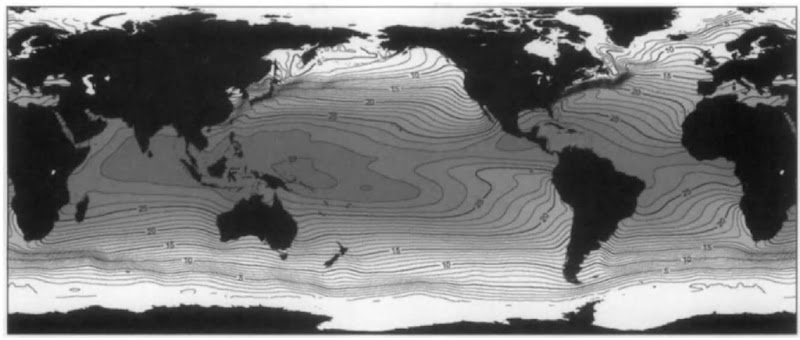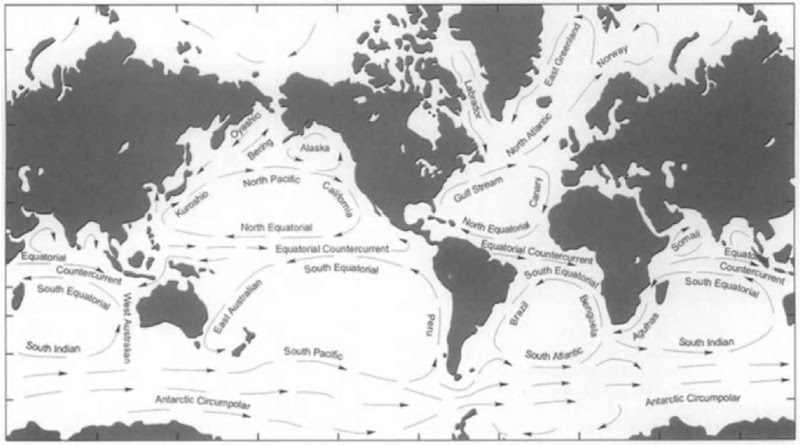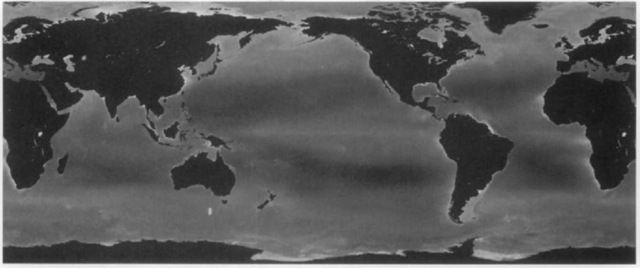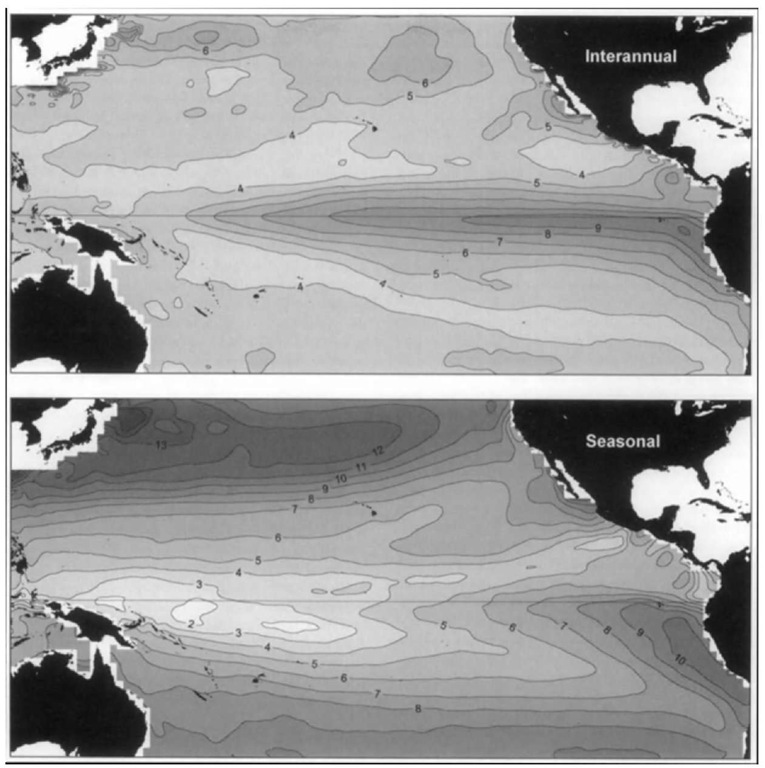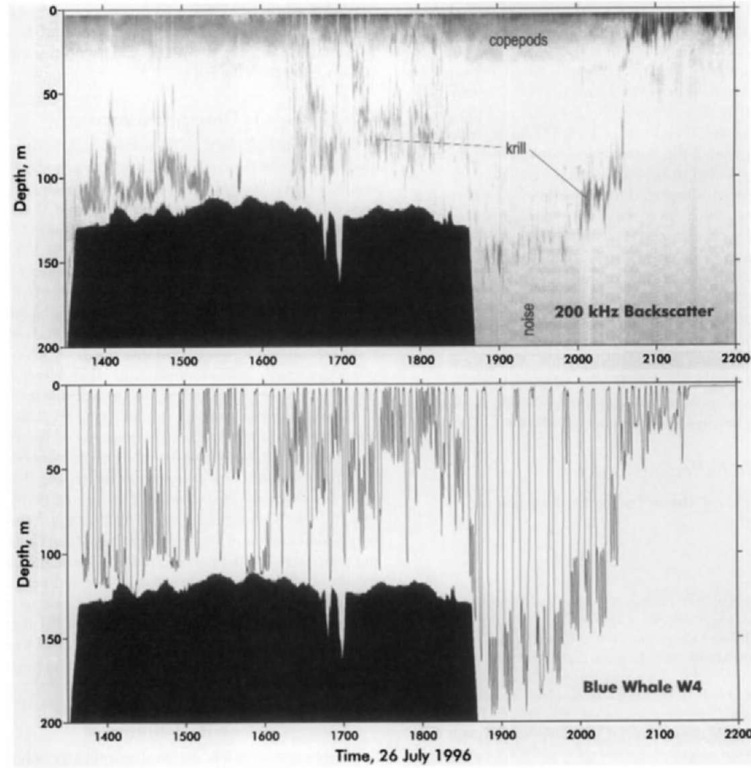Marine mammals live, feed, and reproduce in a vast, i three-dimensional fluid environment—the ocean. Air > * breathing necessitates frequent attendance to the sea surface for all marine mammals, while pinnipeds cannot reproduce in the water and have thus retained a close tie to land or ice. Despite these ties to the boundaries of the ocean environment, oceanography is an important part of the study of marine mammals. Habitat and distribution of marine mammals are affected by the physical and chemical properties of the water through which they swim and communicate, the topography of the ocean bottom where they feed, the physical state of the ocean surface where they breathe and haul out, and numerous factors influencing the distribution of food organisms.
I. Surface Temperature, Salinity
Temperature at the earth and ocean surface generally decreases from the equator to the poles (Fig. 1), but local processes complicate this simple pattern. Upwelling brings cold water to the surface along the equator and along eastern boundaries between oceans and continents. Ocean currents move cold water equatorward along these eastern boundaries and warm water poleward along western boundaries.
Salinity of the surface waters of the open ocean varies between 32 practical salinity units (psu) in the subarctic Pacific and 37 psu in subtropical gyres. This variation affects the density of seawater and thus the distribution of mass and the resulting thermohaline circulation. Salinity variations over this range have little or no physiological effect on marine mammals, but can influence the availability of food organisms through effects on stratification and circulation. At the coastal and polar limits of the ocean and in marginal seas, processes such as local precipitation and evaporation, river runoff, and ice formation can result in salinities less than 10 and greater than 40 psu. Marine mammals have adapted to tolerate even these extremes.
II. Surface Currents, Winds
Surface waters of the ocean are constantly in motion due to waves, tides, and currents. Currents move water across ocean basins and thus alter the distribution of temperature, salinity, and, indirectly, food organisms. Ocean currents are driven by energy from the sun, both by changes in the distribution of mass due to heating and cooling and by wind forcing at the surface. The distribution of solar radiation and rotation of the earth set up a basic pattern of winds consisting of (1) easterly trade winds over low latitudes, (2) westerlies over midlatitudes, and (3) polar easterlies. Heating and cooling of land masses and the seasonal cycle of solar energy input alter this basic pattern.
The surface circulation of most of the area of the world’s oceans consists of subtropical gyres, which move anticycloni-cally (Fig. 2). Equatorial currents move from east to west, western boundary currents (Gulf Stream, Kuroshio) move warm water from near the equator toward the poles, eastward currents (Antarctic Circumpolar, North Pacific) move water back across the oceans on the poleward side of the gyres, and eastern boundary currents (California, Peru, Canary, Benguela) move cold water toward the equator.
The strength of these currents varies seasonally. Eastern and western boundary currents spin off eddies, on the order of 100 km in diameter, which move both water and prey organisms and alter the distribution of favorable habitat for marine mammals. Eastern boundary currents are sites of seasonal coastal up-welling, when equatorward winds move surface water offshore and deep nutrient-rich water is brought to the surface. Westward equatorial currents are also sites of upwelling, due to divergence of surface water caused by the rotation of the earth.
III. Vertical Structure
Physical (and biological) variability in the ocean environment is generally much greater in the vertical than in the horizontal dimension. Water temperature may be nearly constant for a few meters or tens of meters below the surface in the mixed layer but then decreases rapidly with depth in the thermocline. Vertical changes in salinity may contribute to this stratification, especially in polar seas. Stratification influences productivity because deeper, colder water has higher nutrient concentrations than the warmer water near the surface. Stratification also influences the distribution of food organisms.
Figure 1 Mean sea surface temperature (°C).
IV. Productivity
Biological productivity is the rate of production of living matter; oceanographers often speak of “production,” which is the variable standing stock of living organisms and is closely linked to productivity. Primary productivity in the ocean is the rate of production of plants (phytoplankton) and is often limited by light and nutrient availability, both of which are controlled by physical oceanographic processes. Light intensity at the sea surface varies with latitude and time of year, as well as time of day. Thus, photosynthesis occurs in polar seas only during summer. Light intensity decreases rapidly with depth, so that photosynthesis is possible within only a few meters or tens of meters of the sea surface (Fig. 3).
Figure 3 Mean phytoplankton pigment concentration from SeaWiFS satellite data, 1998-1999, increasing from darker to lighter grays; uniform light gray near the poles indicates missing data.
Plant growth also requires nutrients (nitrate, phosphate, and, for some phytoplankton, silicate). The importance of micronutrients—notably iron—in some regions of the open ocean, such as the Southern Ocean around Antarctica where many baleen whales feed, has been recognized in recent years. Nutrient availability is affected by oceanographic processes including stratification, wind and tidal mixing, circulation, and upwelling.
Marine mammals consume zooplankton, fish, squid, and even other marine mammals. Therefore, distribution and foraging are not directly determined by primary production. Food chains involving marine mammals are as short as diatoms-krill-baleen whales. Sperm whales (Physeter macrocephalus), however, consume large deep-living squid and are at least four steps removed from primary production at the sea surface.
V. Ice
Ice is an important component of the habitat of migratory and endemic marine mammals in both the Arctic and the Southern Ocean. Ice cover varies seasonally with temperature and is also subject to the influence of winds and currents. There must be some open water in any ice-covered habitat utilized by marine mammals to allow access to both air and food. Ice on the sea surface is found in a variety of types (pack ice, icebergs, shore ice, fast ice, drift ice, new ice) and forms (small floes, brash ice, pancake ice, etc.).
Sea ice in the Arctic is tightly packed except at the ice edge. Much of the Arctic Ocean is permanently ice covered. The Antarctic has a broad zone of looser pack ice with many internal leads. Most of this ice melts during summer. Polynyas are areas within the pack ice that are almost always clear of ice. Providing both access to the water and locally enhanced productivity, they are relatively more important in the Arctic than in the Antarctic.
VI. Temporal Variability
The ocean environment varies seasonally, especially at higher latitudes where ice closes accessibility to most species during winter. Seasonal variability in wind-driven upwelling causes significant changes during the year even in the tropics. The ocean environment varies between years as well. The cycle in the ocean-atmosphere system known as the El Nino Southern Oscillation (ENSO) or simply “El Nino” causes major changes in the tropics everv 3 to 5 years. Both seasonal and interannual variability occur in all marine mammal habitats. However, the relative magnitude of variability at each scale varies (Fig. 4).
Marine mammals have experienced climate change—variations in the ocean environment over periods of hundreds to thousands of years—throughout their evolutionary history. Concern is now focused on the possible effects of rapid global warming caused by mankind’s input of excess carbon dioxide into the atmosphere. Scientists generally, although not universally, agree that by 2100 the global average temperature will increase by 1 to 3°C, the sea level will rise by several tens of centimeters, and sea ice coverage will be reduced. Changes in environmental variability on shorter time scales, such as the frequency or magnitude of El Nino events, the amplitude of seasonal cycles, or the frequency or intensity of storms, are possible. Regional changes in precipitation, circulation and upwelling, and UV-B (ultraviolet) radiation are expected.
VII. Effects on Life History and Function
Temperature can be a critical factor in the energy budget of warm-blooded mammals. However, marine mammals live and breed in die polar ice and even small, young harp seals (Pagophilus groenlandicus) are able to tolerate freezing temperatures. Some baleen whale species tend to be slightly larger in the cold Southern Ocean than in the warmer North Pacific. Adaptations, including an insulating blubber layer and an ability to reduce blood circulation to peripheral parts of the body, have reduced the direct influence of temperature on distribution.
Figure 4 Approximate interannual and seasonal ranges in sea surface temperature in the temperate and tropical Pacific in °C.
It has long been believed that large whales migrate from summer polar feeding grounds to warmer tropical breeding grounds because of adverse effects of low temperature on growth and survival of neonates. However, this hypothesis is no longer supported by considerations of energy intake, insulation by blubber, and heat loss. Even though the energy cost of migration may be very low for large whales, adult whales do not optimize their energy budget by migrating to warm tropical or temperate waters.
Cetaceans use undenvater sound in several ways. Odontocetes use high-frequency sound to locate prey individuals and patches over short distances. Mysticetes use low-frequency signals for navigation and communication. While the effects of temperature, salinity, and pressure on the propagation of sound in water are well known, it is not known whether oceanographic variability can affect the use of sound by marine mammals. If blue and fin whales (Balaenoptera muscidus and B. physalus) use the low-frequency sound channel of the deep ocean to acoustically “visualize” their environment, variations in water properties very likely distort or obscure the image they can obtain.
VIII. Effects on Feeding
Marine mammals are generally apex predators, or at the top of the food chain, although some of them are preyed on by killer whales (Orcinus orca) and leopard seals (Hydrurgaleptonyx). Because they are motile, social, and intelligent, they are able to take advantage of prey in locally dense patches. Like all aquatic and terrestrial predators, marine mammals cannot forage efficiently on average concentrations of prey. It has been shown that right whales (Eubalaena spp.) and humpback whales (Megaptera novaeangliae) require concentrations of prey that are more dense than the maximum densities observed by net sampling. This is an indication of the limitations of oceano-graphic sampling, as well as the paucity of prey in the ocean environment. Sampling by acoustic backscattering from echo sounders and by photography with tethered cameras has not revealed small patches of prey of the required densities.
Prey consumed by marine mammals include crustaceans (copepods, euphausiids or krill, amphipods, shrimp), cephalopods (squid), and schooling fish (herring, capelin, cod, mackerel, myctophids or lanternfish, and others). Availability of these prey in dense patches has been linked to oceanographic features, including bathymetry, fronts, eddies, and primary productivity. Except for bathymetry, these features or characteristics of the ocean environment vary over time.
Many baleen whales feed on dense patches of zooplankton or smaller fishes. The distribution of feeding North Atlantic right whales (E. glacialis) can be predicted by surface temperature and bathymetric variables, including depth and slope. These are the simplest oceanographic variables to measure, but they explain the distribution of whales only indirectly through effects on prey. Zooplankton patches are available in productive coastal waters, where upwelling and wind mixing results in high primary production, and in polar seas, where high primary productivity results from summer insolation and enhanced phytoplankton growth at the melting ice edge and even under the ice. The patches are often located at bathymetric features such as the shelf edge, islands, and seamounts, because bathymetry affects circulation and production and serves as a cue for aggregation of krill and fish. Blue whales feed on krill at the ice edge in the Antarctic, but also at the shelf edge off California (Fig. 5).
Along the northeast United States continental shelf, cetaceans tend to frequent distinct regions based on food preferences. Piscivores—humpback, fin, and minke (B. acutoros-trata) whales and bottlenose (Tursiops truncatus), Atlantic white-sided (Lagenorhynchus acutus), and common dolphins (Delphinus delphis)—are most abundant over shallow banks in the western Gulf of Maine and midshelf east of Chesapeake Bay. Planktivores—right, blue, and sei (B. borealis) whales— are most abundant in the western Gulf of Maine and over the western and southern portions of Georges Bank. Teuthivores (squid eaters)—sperm and long-finned pilot (Globicephala melas) whales and Risso’s dolphins (Grampus griseus)—are most abundant at the shelf edge. Most of these patterns can be related to the availability of specific prey. Right whales feed on dense patches of copepods in the vicinity of the Great South Channel. Humpbacks and fin whales feed on a small schooling fish, the American sand lance, which is very abundant on Stell-wagen Bank and Jeffreys Ledge in the Gulf of Maine and is also abundant off Chesapeake Bay.
Cetaceans are distributed over distinct depth ranges along the continental slope in the northwestern Gulf of Mexico. Deep-diving teuthivores, such as Risso’s dolphins, sperm whales, and beaked whales (Ziphiidae), are found near temperature fronts in deep water, where their squid prey may aggregate. Sperm whales are more abundant in regions of high zooplankton biomass and steep topography in the Pacific Ocean, where deep-diving squid are aggregated. Most of the 19th-century sperm whaling grounds in the Pacific were in regions of coastal or oceanic upwelling where primary production is high. However, the occurrence of some whaling grounds in unproductive waters, such as the region around Tahiti, and the absence of catches in productive waters, such as the California upwelling, indicate that other factors affect the availability of prey to whales and/or whales to whalers.
In the Antarctic, both Antarctic fur seals (Arctocephalus gazella.) and minke whales (Balaenoptera bonaerensis) are found in the marginal ice zone, where primary productivity and, presumably, prey availability are enhanced. Winter pack ice extends out beyond the narrow Antarctic continental shelf and over the deep ocean. Minke whales, beaked whales, and several species of seals live in this ice and feed on krill (the euphausiid Euphausia superba), myctophid fish, and squid. As the pack ice retreats in summer, many of these winter residents and other predators, including large baleen whales, male sperm whales, and killer whales follow the ice edge to feed on abundant plankton and nekton. Right whales, feeding on smaller copepods not concentrated at the ice edge, remain in open waters north of the retreating ice.
Ice is an important habitat component for breeding and shelter of pinnipeds. Antarctic ice floes in the marginal ice zone are a refuge for fur seals (Arctocephalus gazella) from preda-tion by killer whales. In contrast, crabeater seals (Lobodon car-cinophaga), are found in the interior of the pack ice where larger, more stable floes provide breeding sites.
In the Arctic, gray (Eschrichtius robustus), bowhead (Balaena mysticetus), and beluga whales (Delphinapterus leucas) migrate into the Chukchi and Beaufort Sea north of Alaska to feed in summer and fall. Bottom-feeding gray whales feed in shallow, ice-free waters; piscivorous belugas feed in deep water near the ice edge; and planktivorous bowhead whales feed closer to the coast where ice cover is less. These distribution differences are clearly related to prey availability. River plumes formed by summer runoff into the Arctic have been shown to limit the distribution of prey and thus determine the distribution of foraging whales.
IX. Effects on Distribution and Migration
The distribution of baleen whales on summer feeding grounds and movement on these feeding grounds are associated with oceanographic features, including fronts between water masses, eddies along these fronts, eddies caused by circulation around islands and capes, and oceanic and coastal upwelling. Prey availability is enhanced by nutrient input and enhanced primary production, or by convergence and aggregation of plankton. Japanese whalers have exploited concentrations of (1) sei whales off Japan where the warm Kuroshio current meets the cold Oyashio, (2) fin whales in a cold cyclonic eddy and in a mixing zone between cold coastal waters and warmer Bering Sea waters in the western subarctic Pacific, (3) fin whales at shelf edge fronts and upwelling zones off islands in the eastern Bering Sea, and (4) blue and fin whales at the polar front north of the Antarctic pack ice.
Figure 5 Track of a blue whale (bottom) diving into and feeding on a layer of krill (top) at the shelf edge off Santa Rosa Island, California. Reprinted from Deep-Sea Research II, 45, Fiedler, P. C., et al., Blue whale habitat and prey in the California Channel Islands, pp. 1781-1801, Copyright 1998, with permission of Elsevier Science.
Relatively little is known about the migration routes of most baleen whales between summer feeding grounds and winter breeding grounds. Gray whales migrating south along the California coast remain near the coast and apparently use bottom topography for navigation. Humpback whales have been tagged off Hawaii and observed to linger at seamounts in the middle of the North Pacific on the way to summer feeding grounds in the Gulf of Alaska. Seamounts are known to be sites of aggregation of fish. These whales may be feeding, regrouping, or simply navigating.
X. Effects of Climate Change
Direct effects of temperature increase are unlikely for most marine mammals because of their mobility and thermoregulatory ability. However, direct effects could occur for populations at the limits of their range or with physical limits to migration. For example, the vaquita (Phocoena sinus) is a rare species trapped at the warm northern end of the Gulf of California. Other species, such as the beluga whale, with low skin pigmentation and living in a polar region subject to atmospheric ozone depletion, may suffer direct effects of increased UV-B radiation.
Indirect effects on marine mammal populations will occur through alterations of habitat characteristics and distribution, and prey availability. Global warming is predicted to be greatest at high latitudes in the Northern Hemisphere. The resulting reduction of ice cover in the Arctic will affect ice-associated species through changes in the distribution of critical habitat such as polynyas and the ice edge. Seasonal and geographical shifts in prey availability in both the Arctic and the Antarctic may have a variety of indirect effects: nutritional status and reproductive success, geographic range, and timing or patterns of migration. Bowhead whales and narwhals (Monodon monoceros), and especially beluga whales, which feed close to the ice edge, will be affected by reduced ice extent in the Arctic. Warming could also reduce die extent of pack ice in the Antarctic and thus affect the distribution and abundance of krill. Declining krill abundance in the region of the Antarctic Peninsula during the early 1990s has been linked to low winter sea ice extent.
Global warming is expected to be less intense at lower latitudes. However, reduction in wind-driven coastal and equatorial upwelling is possible and may reduce prey availability for marine mammals. A decline in zooplankton biomass off California since 1951 has been linked to warming of surface waters, increased stratification, and reduced mixing and upwelling of nutrients. Odontocetes that depend on squid, such as sperm whales, may be affected more adversely because cephalopod populations are known to be highly variable. A rising sea level will change the lagoons and shelf areas where gray whales and humpbacks breed, but past changes in these breeding sites are known to have occurred over longer periods of geologic time.
